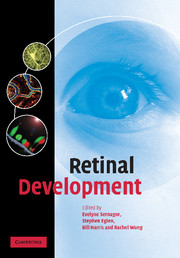Book contents
- Frontmatter
- Contents
- List of contributors
- Foreword
- Preface
- Acknowledgements
- 1 Introduction – from eye field to eyesight
- 2 Formation of the eye field
- 3 Retinal neurogenesis
- 4 Cell migration
- 5 Cell determination
- 6 Neurotransmitters and neurotrophins
- 7 Comparison of development of the primate fovea centralis with peripheral retina
- 8 Optic nerve formation
- 9 Glial cells in the developing retina
- 10 Retinal mosaics
- 11 Programmed cell death
- 12 Dendritic growth
- 13 Synaptogenesis and early neural activity
- 14 Emergence of light responses
- New perspectives
- Index
- Plate section
- References
Preface
Published online by Cambridge University Press: 22 August 2009
- Frontmatter
- Contents
- List of contributors
- Foreword
- Preface
- Acknowledgements
- 1 Introduction – from eye field to eyesight
- 2 Formation of the eye field
- 3 Retinal neurogenesis
- 4 Cell migration
- 5 Cell determination
- 6 Neurotransmitters and neurotrophins
- 7 Comparison of development of the primate fovea centralis with peripheral retina
- 8 Optic nerve formation
- 9 Glial cells in the developing retina
- 10 Retinal mosaics
- 11 Programmed cell death
- 12 Dendritic growth
- 13 Synaptogenesis and early neural activity
- 14 Emergence of light responses
- New perspectives
- Index
- Plate section
- References
Summary
Vision is undoubtedly our most ‘cherished’ sense, and blindness the most tragic loss in perceiving the world around us. Visual perception begins in the eye, of which the retina is the most important component for interpreting visual signals, including colour, shape and movement. The retina is an ocular extension of the brain specialized in receiving and processing light and images. Although it is merely a few 100 micrometres thick and contains only seven cell types, the retina performs very sophisticated visual processing. Ultimately, it sends ALL information about the outside world to visual centres of the brain via the optic nerve in the form of coded electrical impulses. Understanding how the retina is organized and how it functions is thus of fundamental importance for understanding the entire visual system. It is therefore not surprising that the retina has been the focus of attention of many scientists since the late nineteenth century, when Cajal, in 1893, provided the first account of the anatomical organization of the vertebrate retina.
Although our knowledge of how the retina is organized and functions in adult organisms is absolutely essential, understanding how it is assembled during development is no less important. Indeed, when normal development is impaired, irreversible damage can result, in some cases even blindness. Moreover, understanding how the retina develops is attractive not only to developmental neuroscientists interested in vision, but to all neuroscientists interested in development, because the retina is ‘an approachable part of the brain’, and developmental processes required to build this exquisitely organized system, with well-defined layers and a limited number of cell types, are ultimately relevant to all other parts of the central nervous system.
- Type
- Chapter
- Information
- Retinal Development , pp. xiii - xivPublisher: Cambridge University PressPrint publication year: 2006



